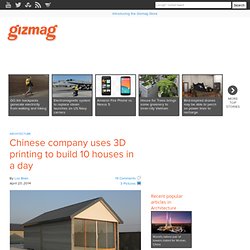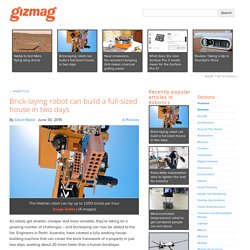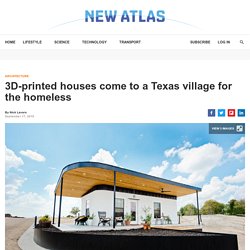

The schools of the future could be 3D printed. World’s largest 3D-printed building completed in Dubai by Apis Cor. The world of architectural 3D printing is in its superlative phase.

Companies are competing to build the biggest, best, and most impactful 3D-printed structures with constantly advancing technology. Dubai, home to the world’s tallest building, is unsurprisingly laying claim to the world’s largest 3D-printed building. At least for now. The city tapped Nasa-award-winning 3D-printing company Apis Cor to build a two-story municipal administrative building that stretches 31 feet high and across 6,900 square feet.
A single machine extruded a concrete mixture into layers that serve as the building’s walls. 3D-printed house is made from biodegradable materials. Chinese company uses 3D printing to build 10 houses in a day. Small home constructed from 3D-printed building blocks (Image: Winsun New Materials) Image Gallery (3 images) This small home may look plain, but it represents a significant achievement in rapid construction.

A Chinese company has demonstrated the capabilities of its giant 3D printer by rapidly constructing 10 houses in less than 24 hours. Built from predominantly recycled materials, these homes cost less than US$5,000 and could be rolled out en masse to ease housing crises in developing countries. If you’ve been to a major city in China recently, you’ll have noticed a theme. Outside the major urban centers, there’s still a vast need for quick, cheap housing, and Suzhou-based construction materials firm Winsun has stepped forward with a very impressive demonstration of rapid construction by using 3D printing techniques to build 10 small houses in 24 hours using predominantly recycled materials.
The printer is 6.6 m (22 ft) tall, 10 m (33 ft) wide and 32 m (105 ft) long. About the Author. Brick-laying robot can build a full-sized house in two days. As robots get smarter, cheaper and more versatile, they're taking on a growing number of challenges – and bricklaying can now be added to the list.

Engineers in Perth, Australia, have created a fully working house-building machine that can create the brick framework of a property in just two days, working about 20 times faster than a human bricklayer. Named Hadrian (after Hadrian's Wall in the UK), the robot has a top laying speed of 1,000 bricks per hour, which works out as the equivalent of about 150 homes a year. Of course there's no need for the machine to sleep, eat or take tea breaks either, giving it another advantage over manual laborers.
At the heart of Hadrian is a 28 m (92 ft) articulated telescopic boom. Though mounted on an excavator in the photo below, the finished version will sit on a truck, allowing it easier movement from place to place. The boom auto-corrects itself 1,000 times per second to prevent interference from vibrations or sway. DUS Architects builds 3D-printed micro home in Amsterdam. Dutch studio DUS Architects has 3D printed an eight-square-metre cabin and accompanying bathtub in Amsterdam, and is now inviting guests to stay overnight (+ slideshow).

DUS Architects used sustainable bio-plastic to create the 3D Print Urban Cabin, which is intended to demonstrate how additive manufacturing can offer solutions for temporary housing or disaster relief. When the cabin is no longer needed, it can be destroyed and almost all the materials can be reused. "The building is a research into compact and sustainable dwelling solutions in urban environments," said the team. Prototype low-cost house is 3D-printed using mud. 3D homes that take 24 hours and less than $4,000 to print - Business Insider. Printing lab at UNM puts school ahead of the curve.
Civil engineer and doctoral candidate Daniel Marcia, left, and civil engineer Dr.

Moneeb Genedy operate UNM’s new 3D concrete printer. (Courtesy of UNM) The University of New Mexico could become a national leader in research, development and training for emerging 3D construction printing technologies, thanks to the new Dana C. Wood Materials and Structures Lab at the School of Electrical and Computer Engineering. The lab, which opened last month and is located on the ground floor of UNM’s Centennial Engineering Building, thrusts the Department of Civil, Construction and Environmental Engineering into the forefront of next-generation trends in the construction industry, according to Mahmoud Taha, department chair and distinguished professor. The lab includes two new 3D concrete printers, as well as 3D carbon fiber printing technology that can create components and materials for the construction of everything from buildings to bridges. “It makes us very competitive,” Christodoulou said.
3D-printed houses come to a Texas village for the homeless. From space exploration to robotics to medicine, 3D printing has huge potential in all kinds of areas, but one where it is starting to make a real impact is the world of low-cost housing.

Rael San Fratello 3D prints mud structures as prototypes for low-cost construction. To explore the possibilities of mud architecture, Rael San Fratello has created 3D-printed prototypes that take cues from historical earthen construction built along the Rio Grande river.

Led by architects Ronald Rael and Virginia San Fratello, Rael San Fratello created four mud structures as part of its Emerging Objects investigative series into 3D printing. The project called Mud Frontiers resulted in 3D-printed designs – Hearth, Beacon, Lookout and Kiln – that the studio believes could help to provide solutions for more affordable construction. The structures take cues from the origins of the Rio Grande watershed in Colorado's San Luis Valley, formerly the edge of the US-Mexico before 1848. Here, traditions from Ancestral Pueblo cultures date back to 700 CE and the Indo-Hispano cultures of northern New Mexico and southern Colorado date back to 1598.